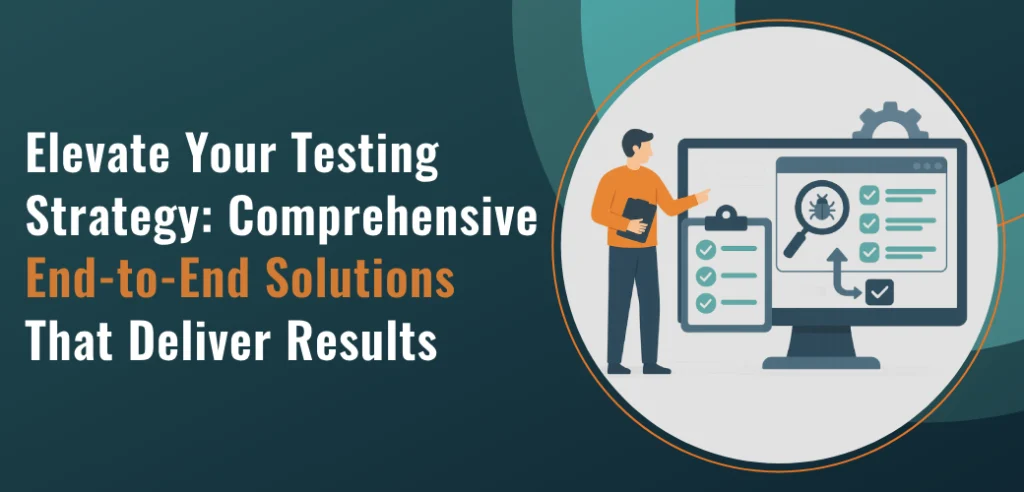
In today’s fast-paced digital landscape, delivering high-quality software applications is non-negotiable. Users expect seamless experiences across all platforms, and even minor bugs can lead to significant user dissatisfaction. End-to-end (E2E) testing has emerged as a critical component in ensuring software quality by validating the entire application flow from start to finish. This comprehensive guide explores everything you need to know about E2E testing solutions, their importance, implementation strategies, and how they can transform your software development lifecycle.
What is End-to-End Testing?
End-to-end testing is a comprehensive testing methodology that validates the complete functionality of an application by simulating real-world user scenarios. Unlike other testing methods that focus on individual components, E2E testing examines how all parts of the application work together, including databases, servers, APIs, and the user interface.
The primary objective of E2E testing is to provide developers with insights into the user experience by replicating actual user interactions. This approach ensures that the entire application flow functions without setbacks, thoroughly validating all essential components within the test environment.
Key Characteristics of E2E Testing:
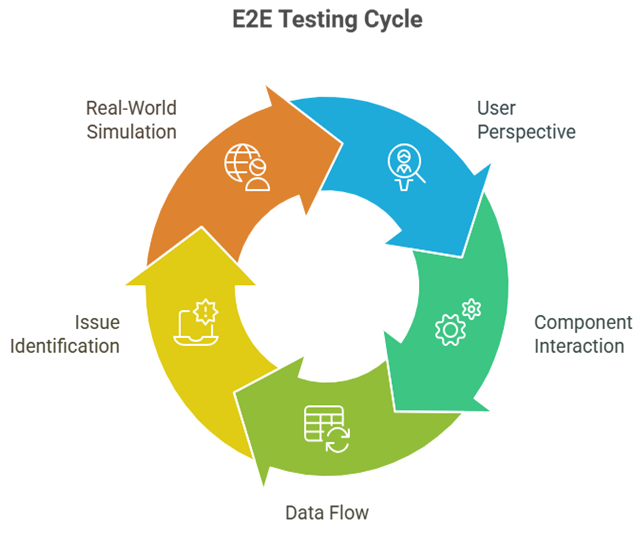
- Tests the application from the user’s perspective
- Validates interactions between different components
- Ensures data flows correctly through the entire system
- Identifies issues that might not be visible in unit or integration tests
- Simulates real-world scenarios to ensure optimal user experience
Types of End-to-End Testing Methods
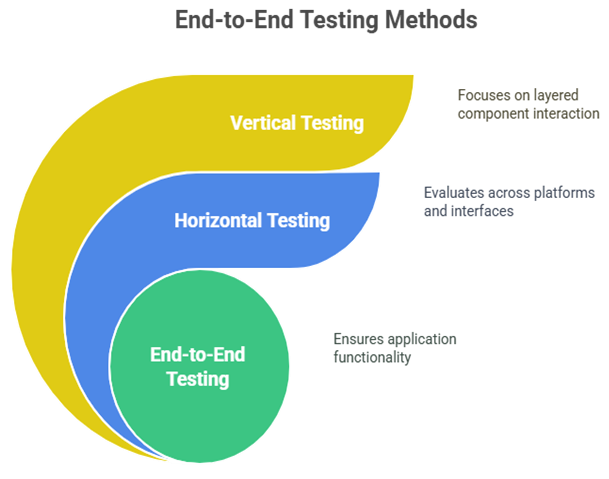
Depending on your testing goals, there are two primary approaches to E2E testing:
Horizontal E2E Testing
Horizontal testing evaluates the application across various platforms, interfaces, or applications that work together. This approach ensures seamless interaction and functionality across different components.
Key aspects of horizontal testing include:
- Cross-platform validation across different operating systems, browsers, and devices
- User-centric perspective that simulates real-world scenarios
- Integration testing between various modules and components
- End-to-end flow coverage spanning multiple components or systems
- Usability and compatibility checks in different environments
Vertical E2E Testing
Vertical testing is conducted sequentially and hierarchically, focusing on testing the application’s various layers or components from top to bottom. This approach ensures that each layer interacts correctly with those above and below it.
Key aspects of vertical testing include:
- Layered validation focuses on each component independently and in relation to the entire system
- Verification of data and process flow between different layers
- Suitability for complex applications with multiple interconnected components
- Effectiveness for applications with intricate internal workings
- Applicability to non-UI systems like backend services, APIs, or microservices
Why End-to-End Testing Solutions Matter
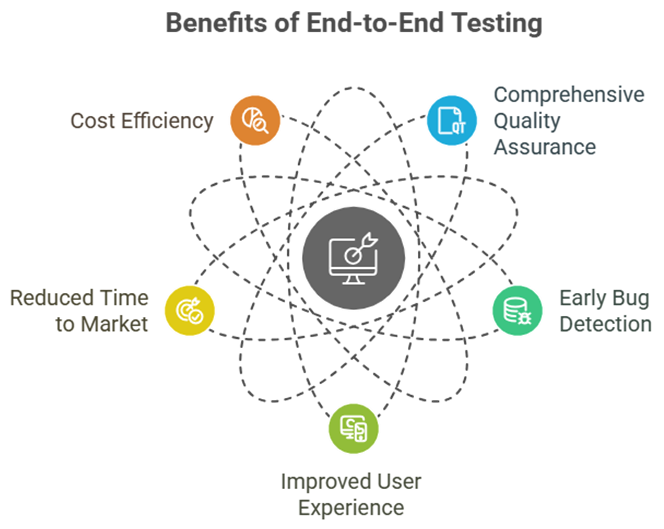
E2E testing solutions have become essential in modern software development for several compelling reasons:
Comprehensive Quality Assurance
E2E testing provides a holistic view of the application’s performance and functionality. By simulating real user scenarios, it ensures that the application will perform as intended in the real world, enhancing user satisfaction and reducing the risk of production failures.
Early Bug Detection
By identifying issues that might not be visible in unit or integration tests, E2E testing helps catch problems early in the development cycle. This early detection significantly reduces the cost and effort required to fix bugs later in the development process.
Improved User Experience
E2E testing focuses on the user’s journey through the application, ensuring that all critical paths function correctly. This user-centric approach leads to more reliable, intuitive, and user-friendly applications that meet or exceed user expectations.
Reduced Time to Market
Automated E2E testing streamlines the testing process, allowing teams to validate critical user paths more efficiently. This automation reduces the overall testing time, enabling faster releases and shorter time-to-market for new features.
Cost Efficiency
While initially requiring investment, E2E testing ultimately reduces the cost of building and maintaining software by decreasing the time spent on manual testing and fixing bugs in production.
How to Implement End-to-End Testing Solutions
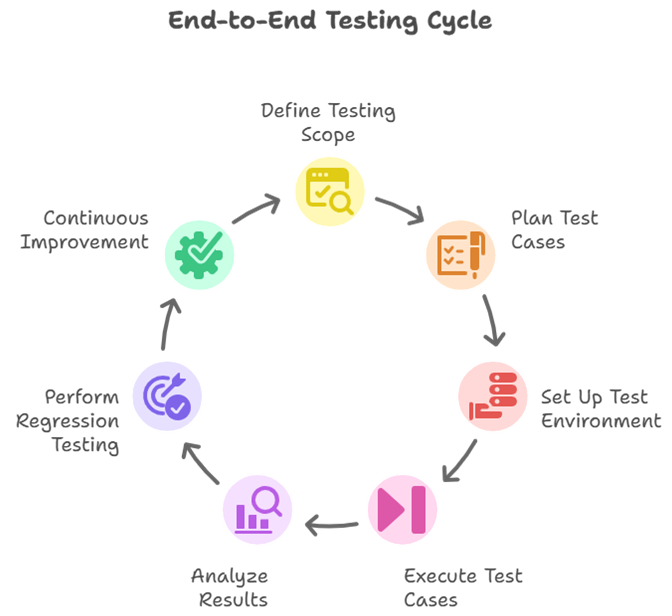
Implementing effective E2E testing solutions requires careful planning and execution. Here’s a step-by-step approach:
Define Testing Scope and Objectives
Before diving into testing, clearly define what needs to be tested and why. This involves understanding the application’s workflow, critical business processes, and user interactions that require testing. Establish success criteria to assess whether test cases have passed or failed.
Planning for Test Cases
Once you have a clear scope, plan your test cases to cover all functionalities and user interactions. Consider:
- Common user scenarios and behaviors
- Required test data and expected outcomes
- Integration points between different system components
Set Up the Test Environment
Create a test environment that closely replicates the production environment. Ensure all necessary hardware, software, networks, and other system components are in place and functioning correctly.
Execute Test Cases
With your test cases and environment ready, begin executing the tests:
- Run tests according to planned scenarios
- Monitor the system’s behavior and outputs
- Document test results, including failures and anomalies
Analyze Results and Report
After testing, analyze the outcomes by comparing actual results with expected outcomes. Document any discrepancies and report issues to the development team for resolution.
Perform Regression Testing
Once issues are resolved, run regression tests to ensure that fixes haven’t affected existing functionalities. This helps maintain the stability and reliability of the software.
Continuous Improvement
E2E testing is an ongoing process. Learn from each testing cycle, refine your test cases, update testing methods, and improve your overall testing strategy to enhance software quality over time.
End-to-End Testing Success Metrics

To measure the effectiveness of your E2E testing solutions, consider these key metrics:
Test Coverage
This metric assesses how thoroughly your testing has covered all defined scenarios and requirements. Higher coverage indicates more comprehensive examination of the application’s functionalities.
Defect Density
Defect density measures the number of defects found per unit of functionality or code. This metric helps identify areas that may require more focused testing or improvement.
Mean Time to Detect (MTTD)
MTTD is the average time taken to detect a defect during testing. A lower MTTD indicates a more effective testing process.
Mean Time to Repair (MTTR)
MTTR measures the average time required to fix a defect once identified. Efficient processes and skilled teams typically have shorter MTTRs, leading to faster release cycles.
Test Automation Percentage
This metric tracks the percentage of automated tests versus manual tests. Higher automation generally leads to more efficient testing phases.
Pass/Fail Rate
This straightforward metric tracks the number of tests that pass versus those that fail. A high pass rate indicates good application health.
Challenges in End-to-End Testing and How to Overcome Them
While E2E testing offers numerous benefits, it also presents several challenges:
Time-Consuming Process
E2E testing can be time-consuming to set up and execute due to the complexity of simulating real user interactions across multiple components and systems.
Solution: Focus E2E tests on the most critical user workflows and integrate them into your CI/CD pipeline to run automatically during appropriate stages of development.
Test Design Complexity
Designing effective E2E tests requires considering numerous components and environments, which can be challenging and potentially lead to budget overruns.
Solution: Start with a small set of critical test cases and gradually expand your test suite as you gain experience and refine your approach.
Understanding User Goals
Creating effective E2E tests requires a deep understanding of user intentions and behaviors, which not all development teams possess.
Solution: Incorporate user research and feedback into your testing strategy and consider involving actual users in beta testing to gain valuable insights.
Maintenance Challenges
E2E tests can be brittle and require frequent maintenance, especially when the application undergoes significant changes.
Solution: Design tests with maintainability in mind, use stable selectors, and implement proper abstraction layers to minimize maintenance efforts.
Best Practices for End-to-End Testing

To maximize the effectiveness of your E2E testing solutions, follow these best practices:
Define Clear Objectives
Establish specific goals for your E2E testing efforts, ensuring your chosen scenarios represent real-world use cases.
Use Appropriate Tools
Select testing tools that best fit your application’s technology stack and testing requirements, considering factors like ease of use, community support, and integration capabilities.
Creating a Comprehensive Test Plan
Outline all steps, from test case creation to execution and result analysis, to ensure a structured and thorough testing process.
Automate When Possible
Automate repetitive and time-consuming tests to increase efficiency and accuracy, while maintaining manual testing for exploration and complex scenarios.
Test in Realistic Environments
Ensure your testing environment closely resembles the production environment to identify environment-specific issues early.
Monitor and Analyze Results
Regularly review test results for insights and potential improvements in both the testing process and the application itself.
Collaborate and Communicate
Encourage collaboration between developers, testers, and stakeholders to ensure that E2E testing aligns with user expectations and business goals.
How ideyaLabs Transforms End-to-End Testing
At ideyaLabs, we understand the critical role that comprehensive E2E testing plays in delivering exceptional software products. Our specialized testing services combine industry’s best practices with innovative approaches to ensure your applications meet the highest quality standards.
Our End-to-End Testing Approach
ideyaLabs implements a strategic E2E testing methodology that covers all aspects of your application:
- Requirement Analysis: We begin by thoroughly understanding your application’s requirements and user journeys.
- Test Planning: Our experts develop comprehensive test plans tailored to your specific needs.
- Test Environment Setup: We create realistic test environments that mirror your production setup.
- Test Execution: Our team executes both manual and automated tests to ensure complete coverage.
- Defect Reporting and Tracking: We provide detailed reports on identified issues and track them through resolution.
- Continuous Improvement: We constantly refine our testing approach based on results and feedback.
No-Code Automation for Enhanced Testing
ideyaLabs leverages cutting-edge no-code automation tools to transform software testing. This approach allows for:
- Faster test creation and execution
- Reduced dependency on specialized programming skills
- Greater involvement from business analysts and domain experts
- More agile response to changing requirements
- Significant cost savings compared to traditional testing approaches
By combining traditional testing expertise with innovative no-code solutions, ideyaLabs delivers comprehensive E2E testing that ensures your applications perform flawlessly in real-world scenarios.
Conclusion
End-to-end testing solutions are essential for ensuring software quality in today’s competitive market. By validating the entire application flow from the user’s perspective, E2E testing helps identify issues that might otherwise go undetected until they impact real users.
While implementing E2E testing presents challenges, the benefits-including improved user experience, reduced time to market, and lower maintenance costs-make it a worthwhile investment. By following best practices and leveraging appropriate tools, organizations can build robust testing strategies that contribute significantly to software quality and business success.
As software continues to evolve, E2E testing will remain a critical component of the development process, helping teams deliver reliable, high-quality applications that meet and exceed user expectations.
For organizations looking to enhance their testing capabilities, partnering with experienced providers like ideyaLabs can provide the expertise and tools needed to implement effective E2E testing solutions that drive software quality and business success.